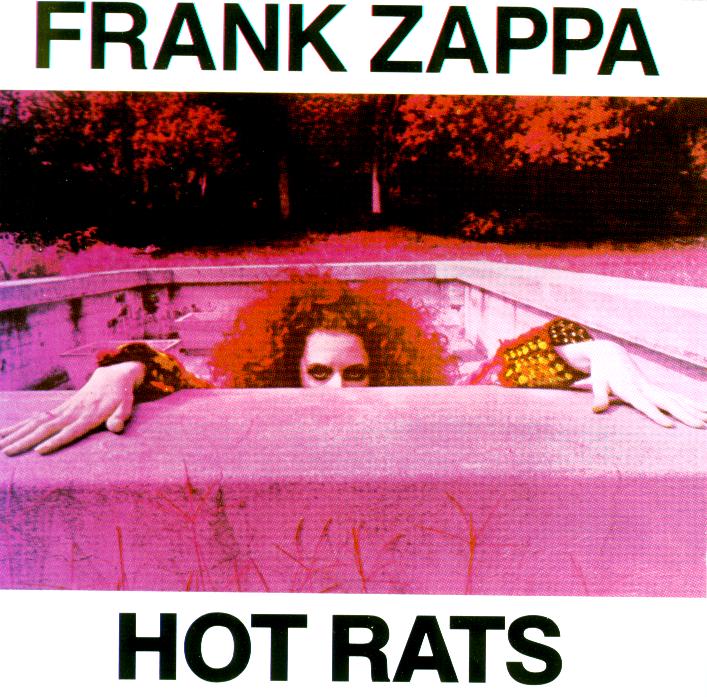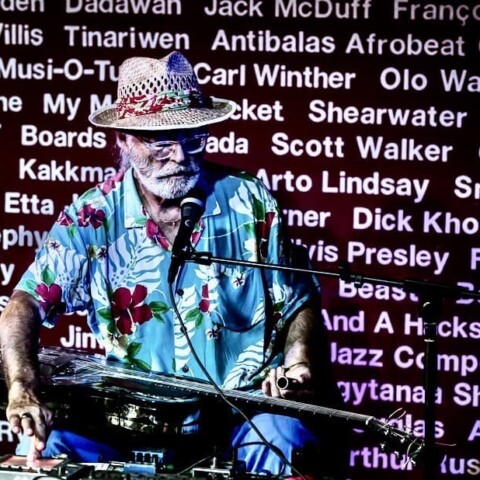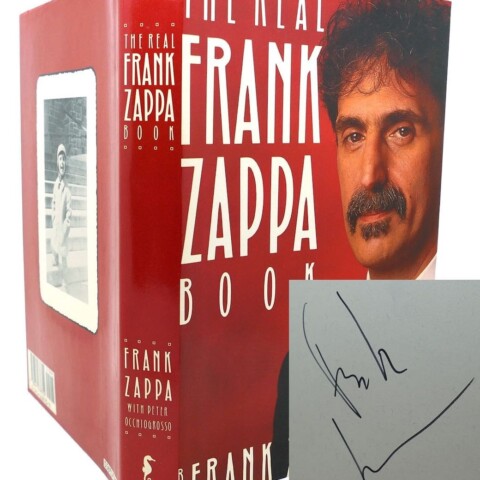With Universal reissuing remastered versions of Frank Zappa’s enormous catalogue, Gary Steel takes up the challenge of reviewing all of FZ’s genius album creations, one by one, and giving them a unique ‘Zappa Rating’. Today’s selection: Hot Rats.
Frank Zappa – Hot Rats (Zappa Records/Universal) #8
 AFTER A SUSTAINED four-year burst of activity with his group, the Mothers Of Invention, everything changed with the release of Zappa’s solo album, Hot Rats, in October 1969. Dumping the Mothers and hiring a load of top-notch session musicians and jazz and blues veterans, Zappa churned out Hot Rats, which was exactly what serious music fans wanted: an album shorn of the comedic turns and mad burlesque and critical social/political commentary that infuriated those who just wanted the music.
AFTER A SUSTAINED four-year burst of activity with his group, the Mothers Of Invention, everything changed with the release of Zappa’s solo album, Hot Rats, in October 1969. Dumping the Mothers and hiring a load of top-notch session musicians and jazz and blues veterans, Zappa churned out Hot Rats, which was exactly what serious music fans wanted: an album shorn of the comedic turns and mad burlesque and critical social/political commentary that infuriated those who just wanted the music.
For many years a favourite of serious fans, it’s still one of his most well-liked and acclaimed albums, and one of the records that made Zappa a “musician’s musician” – the kind of record that budding players would study at music schools, and possibly still do.
Yet despite its status as a jazz-fusion album, Zappa-style, there’s much more to it than that, and like any FZ work, despite the album’s more mainstream pleasures, it does contain provocations to anyone who just wants an easy, smooth ride.
Hot Rats is also a great riposte to the accepted notion that jazz-rock fusion was invented by Miles Davis. As Uncle Meat’s ‘King Kong’ made clear the year before, Zappa’s version of jazz-rock fusion was right there at the vanguard of a movement that included Davis (and many of the musicians he hired to give his band electric smarts), and over in England, groups like The Soft Machine.
But this is Zappa’s version of jazz-rock fusion, and he owns it, completely, and like several other FZ albums, he came up with a style here that could be described as his own genre, but one he scrapped to move on as quickly as he had invented it, restless to try new things and bored without the hijinks of a real rock group to keep him entertained.
 While there’s many facets to Zappa’s jazz-rock fusion, on Hot Rats – using a brand new 16-track desk for the first time – he created a hybrid sound that I prefer to describe as chamber-jazz-rock-fusion, because it’s so ornately arranged and so intricately through-composed that the dots-on-paper, ‘orchestral’ element is probably even more important than the ‘jazz’.
While there’s many facets to Zappa’s jazz-rock fusion, on Hot Rats – using a brand new 16-track desk for the first time – he created a hybrid sound that I prefer to describe as chamber-jazz-rock-fusion, because it’s so ornately arranged and so intricately through-composed that the dots-on-paper, ‘orchestral’ element is probably even more important than the ‘jazz’.
When Zappa first issued Hot Rats on CD in 1987, he had completely remixed the album from its multi-track tapes, and re-inserted some of the overdubs and instrumental layers he said he had to leave off the original vinyl, because the format couldn’t handle it. This remix – which added a few minutes to the already lengthy 12.54 of ‘The Gumbo Variations’, was unsatisfactory to fans, as it was radically different to the version everyone had originally heard and loved.
In fact, it’s not quite as simple as ‘original mix great, Zappa remix bad’: Zappa’s ’87 mix accentuates the chamber orchestral feel, and there’s a lot of detail there that is missing on the original album, and on this new Universal reissue, which is taken from the original analogue masters, and then remastered in 2008 by Bernie Grundman. My original vinyl copy of this album sounds dull and a bit hollowed-out (something that may be explained simply by the fact that it’s an early-to-mid-‘70s re-pressing of a ’69 album, and the pressing masters may have been suffering degradation by this point); the spanking new version packs a punch and a half, and everything sounds clear and dynamic, but it’s missing the extra orchestral flair of the Zappa remix. Clear benefits of the 2012 version of Hot Rats, however, include the return of Max Bennett’s gorgeous bass. There’s a rhythmic groove on Hot Rats that makes it almost funky, and I can see why Zappa almost mixed the bass out of the picture on his ’87 version, because the groove does rather hog the limelight, and FZ would have been more interested in accentuating the compositional integrity. Anyway!
The first track is one of the most popular and well-liked of all Zappa’s instrumentals, ‘Peaches En Regalia’. Its short running time (3.39) still allows FZ to pack a lot in: horns, organ, flute and guitar carry the lovely tune, while there’s also time for a short, snaky guitar solo. There’s something about this zippy little number that makes you never grow tired of it, and there’s even a very short section of sped-up nuttiness, but it flies by so quickly that many probably don’t even register the Zappa idiosyncrasy.
‘Willie The Pimp’ is the fly in the ointment, because it’s basically a blues jam with Captain Beefheart’s gruff voice raging away, and at more than nine minutes, attention can wander. It’s essentially a vehicle for an extended Zappa guitar solo, under which there are some interesting (some would say distracting) stereo-panned percussion hijinks and an insanely repetitively hammered piano. The 1987 mix on this is vastly different: much more widescreen, wider stereo, and there’s much more definition on the guitar solo. The 2012 reissue has more meat on its bones, but the whole portions of the guitar solo lack definition and are almost inaudible amongst the busy instrumentation, making the track rather difficult to connect with.
 ‘Son Of Mr Green Genes’ (a reprise on a theme from Uncle Meat), on the other hand, fully justifies its 9 minute duration. It’s beautifully arranged for unison horns, a great vehicle for extended solos, and the rhythm section is exquisite. It’s probably right here that the idea of Zappa the guitar god got started, and there’s no denying that his guitar picking on these tracks is phenomenal: while it can’t yet boast the sheer sculptural power of his later soloing, he’s fully developed his own technique, and even though it shows the wiry, edge-of-seat bluesiness of Johnny ‘Guitar’ Watson, FZ has developed his own, distinctive instrumental vocabulary. On Hot Rats, Zappa’s guitar playing is fast but not showy, and he’s demonstrably more interested in interrogating ideas (or conjuring the seeds thereof) and digging out those textural details and tiny nuances, than just wanking his wah-wah. [Although he does play a mean wah-wah].
‘Son Of Mr Green Genes’ (a reprise on a theme from Uncle Meat), on the other hand, fully justifies its 9 minute duration. It’s beautifully arranged for unison horns, a great vehicle for extended solos, and the rhythm section is exquisite. It’s probably right here that the idea of Zappa the guitar god got started, and there’s no denying that his guitar picking on these tracks is phenomenal: while it can’t yet boast the sheer sculptural power of his later soloing, he’s fully developed his own technique, and even though it shows the wiry, edge-of-seat bluesiness of Johnny ‘Guitar’ Watson, FZ has developed his own, distinctive instrumental vocabulary. On Hot Rats, Zappa’s guitar playing is fast but not showy, and he’s demonstrably more interested in interrogating ideas (or conjuring the seeds thereof) and digging out those textural details and tiny nuances, than just wanking his wah-wah. [Although he does play a mean wah-wah].
‘Little Umbrellas’ and ‘It Must Be A Camel’ (originally the first and last song on the second side of the vinyl) are two of the loveliest songs Zappa ever wrote, and show that the guy was capable of composing music of exquisite subtlety and beauty. The first is a mere 3.09 in length and an absolute morsel of gorgeousness, capturing a rare sense of dignity and melancholy. At first, it sounds like classic jazz, but by the time the tune and arrangement has evolved towards its conclusion, the listener becomes aware that it actually belongs in some curious interstice between jazz and modern classical composition. The last also oozes beauty: starting with a very cool bass intro, Zappa throws in some perfectly Varese-style scatterbombs of percussion, adding to the sense of intrigue, and his own guitar solo is an exercise in restraint. Desert island stuff!
 Sandwiched in between is all 12.54 of ‘The Gumbo Variations’, a great, grinding, dirty groove with striptease sax and a long violin solo by Don ‘Sugarcane’ Harris where you can virtually see the wax vapour flying off the strings.
Sandwiched in between is all 12.54 of ‘The Gumbo Variations’, a great, grinding, dirty groove with striptease sax and a long violin solo by Don ‘Sugarcane’ Harris where you can virtually see the wax vapour flying off the strings.
Hot Rats is an almost perfectly formed, utterly distinctive, absolutely classic entry into the Zappa canon, and its allure never fades. While short on lyrics, vocals and any particular comedic touches (even the music seldom snickers), it’s a grand and enduring example of Frank Zappa’s musical genius. But I’d be remiss not to mention FZ’s main collaborator here, Ian Underwood, who plays multiple reed instruments as well as organ/piano, and whose arrangemental ability certainly helped to make Hot Rats the classic it undoubtedly is.
I just wish the Zappa Family Trust had decided to present both mixes on this one CD, but I guess there’s still room for a Hot Rats box set somewhere down the line. GARY STEEL
Zappa Rating
Music = 5/5
Sound = 4.5/5
Recommendation: Definitely worth getting for its sonic improvements over the Ryko version, but serious fans need both.
















This is one of the great albums of all time, and in my view Zappa’s greatest. I have a USA pressing from 1983 that sounds superb, presumably a newer cut than the one described in the review as “suffering degradation”. I recently stripped it to 44.1 kHz digital and made a home CD of it via Audacity.